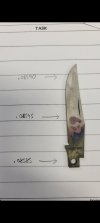- Joined
- Apr 3, 2009
- Messages
- 3,283
Quick update from earlier. I pulled a blade out of the bin. This blade was rough profiled, surface ground with a 180 ceramic trizact, nick cut, stamped and heat treated. Here are my measurements. From here I will do final profile and knock the scale off with a 400 grit ceramic trizact on the SGA. I'll shoot for no more than .002 per side from here. Not a bad tolerance though. I'd say my process is decent. FYI I am using an Ameribrade SGA.







